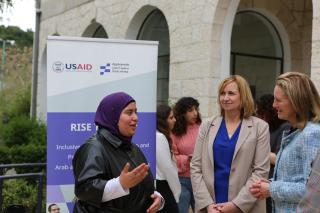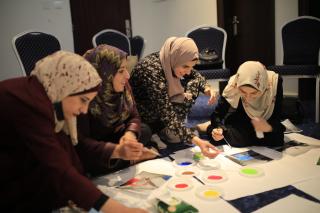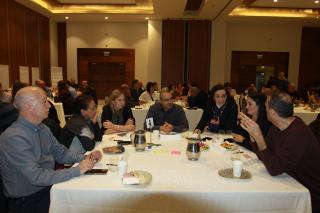Sustainable development is locally-led development.

The future success of the West Bank and Gaza depends on the Palestinians who work every day to move the needle on the multitude of issues facing their societies. USAID’s role is to be a partner and champion of these local actors. USAID provides tools to empower local organizations to be influential changemakers - while also listening to and learning from them to enhance our own approach to development.
USAID provides funding to a variety of partners, including small, local organizations who employ fewer than 20 people. Each partner has a unique approach that they apply to development issues, and USAID works with each one to ensure they achieve their objectives. Today, USAID is working with 1,153 local partners, directing a total of $77 million in resources toward these partnerships.
Read on to learn more about the top five ways USAID empowers local partners.
1. Listening - Understanding the Local Context

USAID brings local stakeholders into the strategy and program development process by asking questions and listening. Before any funding opportunities ever become available, USAID must understand the local context, needs, and capacity. Our goal is to empower local organizations and institutions to lead the development of the West Bank and Gaza, and we cannot do this without listening. This can range from having sector-specific meetings with local technical experts, to hearing the priorities of government officials, to surveying past and current beneficiaries on their needs and perception. Only by listening and using this information to guide our programming can USAID truly be a partner for localization.
2. Paving the Path - Making Opportunities Accessible

Anyone who is familiar with development knows that navigating USAID can be a challenge. USAID has made a number of changes to ensure that the process is accessible to local partners, including launching the “work with USAID” website: https://www.workwithusaid.org/.
Even after an organization understands the process, the West Bank and Gaza mission may announce numerous opportunities for funding throughout the year. How do partners know which opportunity is right for them?
Often, USAID hosts conferences when a new opportunity is posted to give potential partners the chance to hear directly from USAID and ask questions. Before an award is made, USAID and implementing partners work together to identify the partner’s strengths and weaknesses. When applicable, USAID selects the type of award that best suits the program and the organization’s capacity. Then a joint action plan is created to bolster the organization’s capacity of organizational policies and process improvements to be carried out during the USAID partnership. USAID staff work side by side with local organizations to strengthen their internal processes and help them develop as an organization, including financial management and human resources management. Throughout this process, USAID also learns the needs of the local landscape to better tailor our capacity building programs.
3. Finding Diamonds in the Rough - Translating Policies and Procedures to Actions

United States Government policies and procedures can be overwhelming and confusing to partners. With the help of USAID’s in-house team, partners are assisted with the initial steps of an activity to ensure proper compliance with all the terms and conditions of their awards.
Additionally, during a process called “co-creation” USAID’s technical experts work with partner staff to determine the best approach for a project. The intensive, hands-on work of USAID staff helps potential partners build a theory of change and activities to achieve an impact. Co-creation allows our team to identify the “diamonds in the rough” and shape proposals to be ready for current and future USAID direct support.
Over the life of the project, this support continues. In order to guarantee that Implementing Partners are maximizing their goals, USAID staff ensure they work with each partner to discuss potential adjustments to awards based on pivots necessary during implementation. In addition, USAID staff help our partners track special award requirements that address internal control gaps identified prior to award to ensure partners take corrective actions that will not only enable them to comply with the terms and conditions of the award, but also successfully build their organizational capacity.
4. Measuring Success - Ensuring Impact For Those Most in Need

Measuring an activity’s progress and achievements is a key element to ensuring USAID funds go to projects that support the people who need it most. USAID supports partners to meet monitoring and evaluation standards and develop plans, including one-on-one training tailored to each activity. Our staff work directly with partners on improving monitoring processes and ensuring that activities are meeting performance targets.
During implementation, USAID conducts regular check-ins with partners to measure success and identify and address challenges. When warranted, USAID also works with partners to make program adjustments or course corrections and ensures that monitoring plans are updated as required. Because USAID’s support strengthens the partner’s monitoring system, at the end of USAID assistance, local organizations are better positioned to achieve results and notable impact beyond the life of USAID’s investment.
5. “Attention, Attention, Read All About It!” - Messaging and Outreach Support

USAID implements programs in over 100 countries - each operating context and initiative is unique in the audience it targets and the messaging it attempts to impart. For this reason, USAID hires communications specialists to assist and focus on the outreach needs in every location where USAID operates. In the West Bank and Gaza, USAID staff provide communications support both directly and through training opportunities from international and local actors. Training includes photography, elevator pitch development, branding, and one-on-one support for everyday communications needs.
From the very beginning of a project, USAID works with each partner to tailor their communications plan to their project and audience. At USAID West Bank and Gaza, this includes messaging, branding, milestones, events, and communications support for nearly fifty projects.
USAID staff in the West Bank and Gaza Mission work with our partners from the pre-application process, through implementation, and beyond, to champion successful, local actors. USAID empowers local organizations to drive sustainable impact while improving our own approach to development. By partnering with organizations to build local capacity, we ensure our activities are meeting the needs of those we serve using locally led approaches.
Between 2020-2023 USAID will program over $500 million to support the Palestinian people. USAID partners with big and small organizations, empowering Palestinians to build thriving communities, promote inclusive development and advance a two-state solution.
To learn more about USAID and if your organization is ready to apply for USAID funding, check out https://www.workwithusaid.org/.
